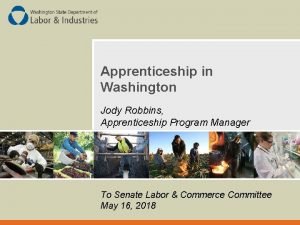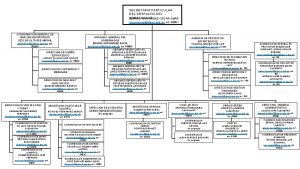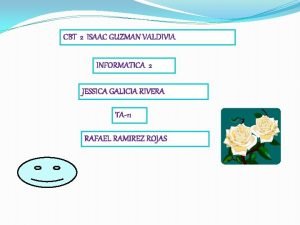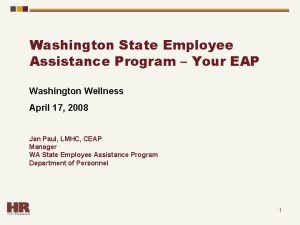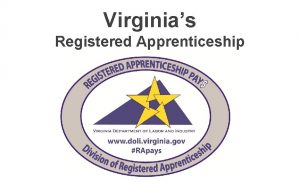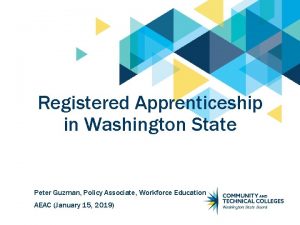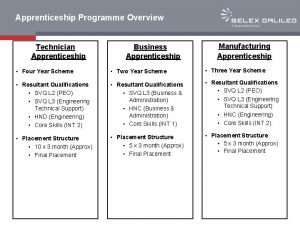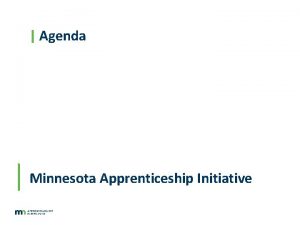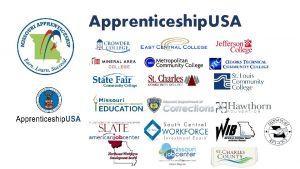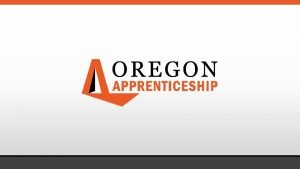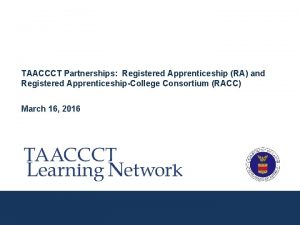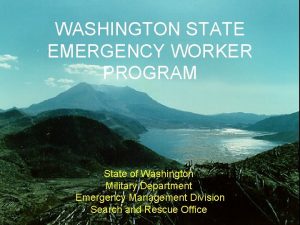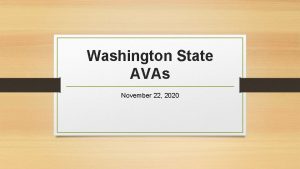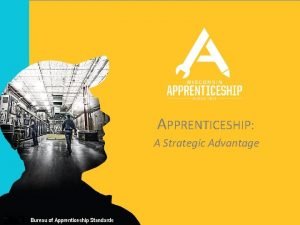Registered Apprenticeship in Washington State Peter Guzman Policy





















- Slides: 21

Registered Apprenticeship in Washington State Peter Guzman, Policy Associate, Workforce Education AEAC (January 15, 2019)

What We’ll Cover • Current interest in Apprenticeship • What is Registered Apprenticeship • General Entrance Requirements for Apprenticeship • Apprenticeship Benefits • Apprentice Demographics in WA • What is Pre Apprenticeship • Apprenticeships in the Community & Technical Colleges • SBCTC’s Regulatory Role in Apprenticeship

Current Interest in Apprenticeship § Companies facing complex workforce challenges in increasingly competitive markets § § § Constantly adapting to innovations & technology Aging workforce of highly-skilled and experienced workers Attracting new and diverse talent pools Closing gaps in workers’ skills and credentials Investing in talent that can keep pace with latest industry advances Can apprenticeship meet the current and future needs of employers in a local and regional labor market?

What is Registered Apprenticeship? • Registered apprenticeship programs combine paid onthe-job training (OJT) and related supplemental instruction (RSI) under the supervision of a journey-level craft person or trade professional in which workers learn the practical and theoretical aspects of a skilled occupation. • Apprenticeship starts with an employer and a Job! • Apprenticeship programs are regulated by the WA State Apprenticeship & Training Council and/or Department of Labor Apprenticeship.

5 Core Components of Registered Apprenticeship Employer Involvement Is Integral Employer is the foundation for the RA program and must be directly involved and provider of OJT. Structured On-the-Job Training (OJT) with Direct Supervision Related Supplemental Instruction Rewards for Skill Gains National or State Registered Reasonably Continuous Employment Structured and Supervised 144 hours required per year College credit at 50% tuition cost Increased Compensation Increased Job Opportunity. Increased Job Mobility Consistent Performance Standards

Value of Apprenticeship • A paycheck from day one, guaranteed to increase over time as new skills are learned – Apprentices earn approximately $300, 000 more over their career than nonapprenticeship participants 1 • Hands-on career training in a wide selection of programs • An education, college credit, and degree pathways • A career once apprenticeship is completed, with a competitive salary, and little or no educational debt • Apprentices can also earn medical and pension benefits • Apprentice wages increase with skill and experience. • Nationwide portability and broad recognition of skills • 1. U. S. Dept. of Labor. Frequently asked questions about the Apprenticeship Program. June 30, 2017. Available at: https//dol. gov. featured/apprenticeship/faqs.

Apprenticeship Occupations • Predominately in the building & construction trades: • Carpenter, Plumber, Electrician, Sheetmetal, Laborer, Operating Engineer, Elevator Constructor, Cement Mason, Ironworker, Painter, Glazier, Bricklayer, Sprinkler fitter, Roofer, etc. • Apprenticeships are also available in: • Aerospace, Machinist, Advanced Manufacturing, Mechanic, Graphic Arts, Fire/Medic, IT, Healthcare, Baker, Meat Cutter, State Patrol Trooper, Embalmer, Para educator, etc. • Advanced Manufacturing, Production Technician – High School Apprenticeship

Non Traditional Apprenticeships • • • Healthcare Finance Insurance Banking Public Sector Supply Chain

Compensation § The average starting wage of an apprentice is between 50 – 60% of a journey workers wage § Apprentices usually earn a raise every six months if training and school performance is satisfactory § Annual earnings: $55, 400 2 2. Workforce Training and Education Coordinating Board Annual data for participants is 2015 -16; January 2018

General Entrance Requirements for Apprenticeship • • Have a GED or High School Diploma Be able to pass a drug and alcohol screen Have a valid drivers I reliable transportation Be at least 18 years old (Except High School Apprenticeship) Work well with others & follow directions Have a good work ethic Be able to work indoors/outdoors in all kinds of weather (Construction/Utilities) Good critical thinking and math skills

Apprenticeship Benefits • You can Earn while you Learn • Provides a sound return on your investment • The revenue generated by an apprentice increases throughout the training • Apprenticeships put a skilled and trained workforce at your fingertips • Apprenticeships foster loyalty

Apprenticeship Benefits Con’t. • • • No student debt National credential Open to a wide range of careers Path to the middle class Be on a great team with support Career advancement

WA State Apprentice Demographics • Active WA State Registered Apprentices Jan. – Dec. 2018: • • Total apprentices – 19, 220 Minority – 5, 580 (29. 03%) Female – 1, 958 (10. 90%) Veteran – 2, 030 (11%) Employment Rate – 75% 3 Annual Earnings –$55, 400 4 ROI/dollar –$26 to $1 5 3. Workforce Training and Education Coordinating Report; Annual data for participants in 2015 -16. 4. Workforce Training and Education Coordinating Report; Annual data for participants in 2015 -16. 5. Workforce Training and Education Coordinating Report; Annual data for participants in 2015 -16.

Now what happens…. • Graduates from apprenticeship programs earn their diploma which we call a: Journey Card

What is Pre Apprenticeship? • Pre Apprenticeship (PA) programs are education based and endorsed by one or more registered apprenticeship sponsors that focus on educating and training students to meet or exceed minimum qualifications for entry into RA. • WA State Apprenticeship & Training Council approves PA programs that meet review criteria. • PA programs seek to articulate and align with RA programs by aligning core competencies

What is Pre Apprenticeship? Con’t • PA criteria includes: • • Alignment of core competencies with RA Incorporates safety training Focus on employability Outreach to diverse populations Incorporate physical fitness Math skills Soft skills Formal articulation agreement with RA

WA State Recognized Pre-Apprenticeship Programs § Apprenticeship and Nontraditional Employment for Women - ANEW § AJAC Industrial Manufacturing Academy – Georgetown, Bates § Pre-Apprenticeship Construction Training (PACT) – SVI § Youth. Build – Georgetown § Pre-Apprenticeship Construction Education (PACE) – WSBCTC § Puget Sound Skills Center - Construction § Tulalip TERO Vocational Training Center – Georgetown, Renton

WA State Recognized Pre-Apprenticeship Programs § Ironworkers Boot Camp – Tukwila § STP - Spokane § TOOL Center – Bates § TRAC – WCCW Purdy § Tulalip TERO Vocational Training Center – Georgetown, Renton § Yakima Valley Skills Center

Apprenticeships in WA Community & Technical Colleges (CTC) • CTC Apprenticeship Facts: • 21 colleges with 193 active apprenticeship programs • 2017/18 Annual Count: • 13255 Headcount; 3827 FTE • Associate of Applied Science Degree (A. A. S. ) & Applied Science Transfer (A. A. S. T) in Multi-Occupational Trades, So Seattle College: • Additional Gen Ed courses can provide 2 pathways to college degrees

SBCTC’s Regulatory Role in Apprenticeship • SBCTC, in partnership with LNI Apprenticeship Manager and the WA State Apprenticeship Coordinator, review and recommend for approval to the WSATC, related supplemental instruction (RSI) that match apprenticeable occupations • SBCTC and its partners make recommendations about the relevance of the instruction in which the following are present: • The RSI compliments and is relevant to the occupation (work) • The RSI is reasonably consistent in method of delivery (instruction)

Contact Information Peter Guzman, Policy Associate pguzman@sbctc. edu 360 -704 -4360 Note: All material licensed under Creative Commons Attribution 4. 0 International License.
 Wa state apprenticeship programs
Wa state apprenticeship programs Pernoctar oraciones
Pernoctar oraciones Guillermo aguilar peralta
Guillermo aguilar peralta Sally guzman edmonds school district
Sally guzman edmonds school district Teoría alemana del acto jurídico
Teoría alemana del acto jurídico Claudia guzman biografia
Claudia guzman biografia Definicion de calidad de crosby
Definicion de calidad de crosby David bernal jalisco
David bernal jalisco Abigael guzman muerte
Abigael guzman muerte Kasukdulan
Kasukdulan Faith guzman
Faith guzman Onel de guzman
Onel de guzman Florentina guzman aroca
Florentina guzman aroca Clara guzman zapater
Clara guzman zapater Gloria guzman ospina
Gloria guzman ospina Manuel guzman
Manuel guzman Onel de guzman wiki
Onel de guzman wiki Cbt 2 isaac guzman valdivia
Cbt 2 isaac guzman valdivia Douglas wilhelm harder
Douglas wilhelm harder Eap washington
Eap washington Washington state geography
Washington state geography Shiba rainbow chart
Shiba rainbow chart
